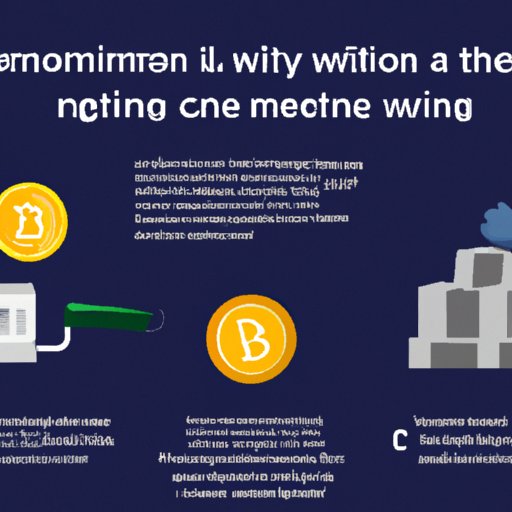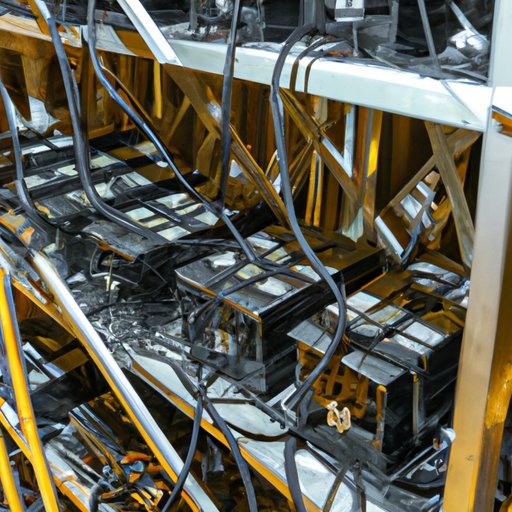
Introduction: Overview of Cryptocurrency Mining: What You Need to Know
Cryptocurrency mining is the process of verifying transactions on a blockchain and adding them to the public ledger. Miners are rewarded with newly-created coins in exchange for their efforts. Mining is essential to the function of a cryptocurrency network, as it ensures that transactions remain secure and immutable. It also provides an incentive for people to participate in the network and support its development.
Mining can be a lucrative endeavor, but it’s not without its risks. Before deciding if mining is right for you, it’s important to understand the pros and cons, the process of mining, and the tools you’ll need to get started.
Pros and Cons of Mining Cryptocurrency
Benefits of Mining
One of the primary benefits of mining cryptocurrency is the potential to earn rewards. As mentioned above, miners are rewarded with newly-generated coins for their work. This reward is typically a fraction of the total value of the transaction fees associated with the block being mined.
In addition to financial rewards, mining cryptocurrency can be a rewarding experience in other ways. Many miners take pride in contributing to the growth of the network, and they enjoy the challenge of optimizing their rigs to maximize profits. Plus, mining can be done from anywhere with an internet connection, making it a great way to generate passive income.
Drawbacks of Mining
Despite its potential rewards, there are some drawbacks to consider before diving into mining. For starters, it can be expensive to set up a mining rig. You’ll need to invest in specialized hardware, software, and electricity, which can add up quickly. There’s also the risk of your hardware becoming obsolete or breaking down, which could lead to significant losses.
Mining is also a competitive field. As more miners join the network, the difficulty of mining increases. This means that more powerful hardware is required to stay profitable. If you’re unable to keep up with the competition, you could end up losing money instead of making it.
How to Mine Cryptocurrency: A Step-by-Step Guide
Choosing a Mining Rig
The first step in setting up a mining rig is choosing the right hardware. ASICs (application-specific integrated circuits) are the most popular choice for mining, as they’re specifically designed to perform the calculations required for mining. GPUs (graphics processing units) are another option, but they’re generally not as efficient as ASICs.
It’s important to note that different types of cryptocurrencies require different types of hardware. For example, Bitcoin requires ASICs, while Ethereum requires GPUs. It’s important to do your research and choose the appropriate hardware for the type of cryptocurrency you want to mine.
Configuring Your Mining Rig
Once you have your mining rig set up, you’ll need to configure it. This includes setting up a wallet to store your mined coins and connecting your mining rig to a mining pool. Mining pools allow miners to combine their computing power and share the rewards among members.
Installing Mining Software
Next, you’ll need to install mining software on your rig. Mining software performs the calculations required to mine cryptocurrency, and it can be customized to optimize your rig’s performance. Popular mining software includes CGMiner, BFGMiner, and EasyMiner.
Joining a Mining Pool
As mentioned above, joining a mining pool is an important step in setting up your mining rig. Mining pools allow miners to combine their computing power and share the rewards among members. When choosing a mining pool, it’s important to consider the fee structure, payout schedule, and server location.
Calculating Profitability: Is Mining Crypto Worth It?
Exploring Return on Investment
Before deciding if mining is right for you, it’s important to calculate your return on investment (ROI). This will help you determine how much money you can expect to make from mining cryptocurrency. To calculate your ROI, you’ll need to factor in the cost of your hardware, the cost of electricity, and the current market value of the coin you’re mining.
Analyzing Difficulty
In addition to ROI, it’s important to consider the difficulty of mining. As more miners join the network, the difficulty of mining increases. This means that more powerful hardware is required to stay profitable. If the difficulty is too high, it may not be worth it to mine the coin.
What Tools Do I Need to Start Mining Cryptocurrency?
Hardware
The most important tool you’ll need to start mining cryptocurrency is hardware. ASICs (application-specific integrated circuits) are the most popular choice for mining, as they’re specifically designed to perform the calculations required for mining. GPUs (graphics processing units) are another option, but they’re generally not as efficient as ASICs.
Software
You’ll also need to install mining software on your rig. Mining software performs the calculations required to mine cryptocurrency, and it can be customized to optimize your rig’s performance. Popular mining software includes CGMiner, BFGMiner, and EasyMiner.

Common Risks and How to Mitigate Them
Security Risks
Security is one of the biggest risks when mining cryptocurrency. Hackers can target mining rigs and steal the coins stored on them. To mitigate this risk, it’s important to keep your mining rig offline and use strong passwords and two-factor authentication whenever possible.
Market Fluctuations
Another risk to consider is market fluctuations. Cryptocurrency prices can fluctuate wildly, which can result in unexpected losses. To mitigate this risk, it’s important to diversify your investments and pay close attention to the market.
Alternatives to Mining Cryptocurrency
Trading
If you’re looking to make money with cryptocurrency without the hassle of mining, trading might be a better option. Trading involves buying and selling coins in order to profit from price fluctuations. It’s a great way to make money, but it’s important to remember that trading carries its own risks.
Staking
Another alternative to mining is staking. Staking involves holding coins in a wallet and being rewarded with newly-generated coins in return. It’s a great way to passively earn rewards, but it’s important to note that not all cryptocurrencies offer staking.
Conclusion
Mining cryptocurrency can be a lucrative endeavor, but it’s important to understand the risks before getting started. It’s essential to calculate your ROI, consider the difficulty of mining, and understand the common risks associated with mining. If you decide that mining isn’t right for you, there are alternatives such as trading and staking.
(Note: Is this article not meeting your expectations? Do you have knowledge or insights to share? Unlock new opportunities and expand your reach by joining our authors team. Click Registration to join us and share your expertise with our readers.)
